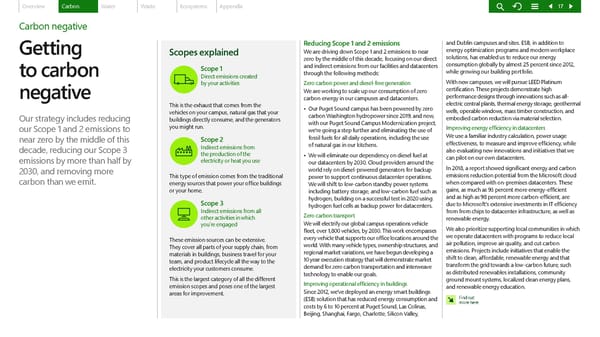Overview Carbon Water Waste Ecosystems Appendix 17 Carbon negative Reducing Scope 1 and 2 emissions and Dublin campuses and sites. ESB, in addition to Getting Scopes explained We are driving down Scope 1 and 2 emissions to near energy optimization programs and modern workplace zero by the middle of this decade, focusing on our direct solutions, has enabled us to reduce our energy Scope 1 and indirect emissions from our facilities and datacenters consumption globally by almost 25 percent since 2012, to carbon Direct emissions created through the following methods: while growing our building portfolio. by your activities Zero carbon power and diesel-free generation With new campuses, we will pursue LEED Platinum We are working to scale up our consumption of zero certification. These projects demonstrate high negative carbon energy in our campuses and datacenters. performance designs through innovations such as all- This is the exhaust that comes from the • Our Puget Sound campus has been powered by zero electric central plants, thermal energy storage, geothermal vehicles on your campus, natural gas that your carbon Washington hydropower since 2019, and now, wells, operable windows, mass timber construction, and Our strategy includes reducing buildings directly consume, and the generators with our Puget Sound Campus Modernization project, embodied carbon reduction via material selection. our Scope 1 and 2 emissions to you might run. we’re going a step further and eliminating the use of Improving energy efficiency in datacenters near zero by the middle of this Scope 2 fossil fuels for all daily operations, including the use We use a familiar industry calculation, power usage Indirect emissions from of natural gas in our kitchens. effectiveness, to measure and improve efficiency, while decade, reducing our Scope 3 the production of the • We will eliminate our dependency on diesel fuel at also evaluating new innovations and initiatives that we emissions by more than half by electricity or heat you use our datacenters by 2030. Cloud providers around the can pilot on our own datacenters. 2030, and removing more world rely on diesel-powered generators for backup In 2018, a report showed significant energy and carbon This type of emission comes from the traditional power to support continuous datacenter operations. emissions reduction potential from the Microsoft cloud carbon than we emit. energy sources that power your office buildings We will shift to low-carbon standby power systems when compared with on-premises datacenters. These or your home. including battery storage, and low-carbon fuel such as gains, as much as 93 percent more energy-efficient Scope 3 hydrogen, building on a successful test in 2020 using and as high as 98 percent more carbon-efficient, are hydrogen fuel cells as backup power for datacenters. due to Microsoft’s extensive investments in IT efficiency Indirect emissions from all Zero carbon transport from from chips to datacenter infrastructure, as well as other activities in which renewable energy. you΄re engaged We will electrify our global campus operations vehicle We also prioritize supporting local communities in which fleet, over 1,800 vehicles, by 2030. This work encompasses we operate datacenters with programs to reduce local These emission sources can be extensive. every vehicle that supports our office locations around the air pollution, improve air quality, and cut carbon They cover all parts of your supply chain, from world. With many vehicle types, ownership structures, and emissions. Projects include initiatives that enable the materials in buildings, business travel for your regional market variations, we have begun developing a shift to clean, affordable, renewable energy and that team, and product lifecycle all the way to the 10 year execution strategy that will demonstrate market transform the grid towards a low-carbon future, such electricity your customers consume. demand for zero carbon transportation and interweave as distributed renewables installations, community This is the largest category of all the different technology to enable our goals. ground mount systems, localized clean energy plans, emission scopes and poses one of the largest Improving operational efficiency in buildings and renewable energy education. areas for improvement. Since 2012, we’ve deployed an energy smart buildings (ESB) solution that has reduced energy consumption and Find out costs by 6 to 10 percent at Puget Sound, Las Colinas, more here Beijing, Shanghai, Fargo, Charlotte, Silicon Valley,
 Microsoft Environmental Sustainability Report 2020 Page 16 Page 18
Microsoft Environmental Sustainability Report 2020 Page 16 Page 18